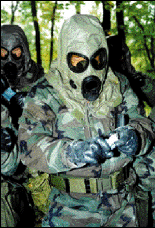Sensor Warns of Biological Warfare
Michael D. WheelerWASHINGTON -- Researchers at the Naval Research Laboratory's Center for Bio/Molecular Science and Engineering have developed a multichannel biosensor capable of providing early detection of anthrax and other lethal biological agents.
Now in advanced prototype form, the sensor soon could become an indispensable tool against biological warfare -- an area in which the US has few safeguards.
The brick-size device simultaneously monitors four fluorescence-based fiber optic biosensors using a fiber array interrogation strategy. Excitation is provided by an axially located, 100-µm-core glass fiber, while fluorescence generated during the assay is detected by 500-µm, high numerical aperture fibers arrayed symmetrically around the glass fiber. Fluorescence is triggered when a toxin comes in contact with the waveguide, which is coated with an antibody.

The Naval Research Laboratory's new handheld biosensor could provide another line of defense for soldiers facing increasing exposure to chemical and biological toxins.< |
The intensity of the fluorescence indicates how much botulism, anthrax or ricin is in the sample. And because the device is an evanescent wave sensor, it is very sensitive.
Evanescent wave sensors penetrate only a fraction of a wavelength into the sampling medium. This reduces the background fluorescence from the sample. Because the signal is generated as the binding occurs, users observe a rapid, near-real-time response.
LATEST NEWS
- Exail Signs LLNL Contract, Partners with Eelume Apr 26, 2024
- Menlo Moves U.S. HQ: Week in Brief: 4/26/2024 Apr 26, 2024
- Optofluidics Platform Keys Label-, Amplification-Free Rapid Diagnostic Tool Apr 25, 2024
- DUV Lasers Made with Nonlinear Crystals Enhance Lithography Performance Apr 25, 2024
- Teledyne e2v, Airy3D Collaborate on 3D Vision Solutions Apr 24, 2024
- One-Step Hologram Generation Speeds 3D Display Creation Apr 24, 2024
- Innovation Award Winners for Laser Technology Honored in Aachen Apr 23, 2024
- Intech 2024: AI Arrives on the Shop Floor Apr 22, 2024
